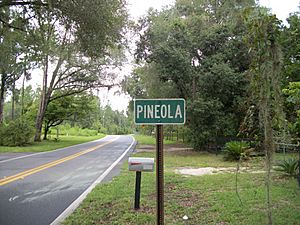Pineola, Florida facts for kids
Pineola is a small, quiet community in southeastern Citrus County, Florida. It's not a city with its own government, but rather a group of homes and land. You can find Pineola along County Road 39, south of Floral City. Its ZIP Code is 33536.
Contents
Pineola's Natural Wonders and Mining History
Pineola was once known for its special natural features. These included the Pineola Grotto and tall limestone cliffs. A grotto is like a small cave, often formed by sinkholes in limestone. These areas were home to unique ferns and other plants. Famous plant experts even came to study them in the late 1800s. They found several plant types that had never been seen before!
Sadly, much of this natural beauty has been lost. Mining for limestone and other building projects changed the landscape. The community of Pineola itself may have grown because of the limestone industry in the early 1900s. Companies like the Pineola Lime Company dug up limestone from quarries here. Today, Pineola is mostly a rural area with a few homes.
The Great Train Wreck of 1956
Pineola is also famous for a major event called "The Great Train Wreck of 1956." This terrible accident happened on October 18, 1956. It was a dark and foggy morning when two Atlantic Coast Line Railroad freight trains crashed head-on. Four crew members died in the collision.
You can find a signpost on the Withlacoochee State Trail that tells the story of this event. It marks the exact spot where the crash happened.
What Happened During the Train Wreck?
The signpost explains the details of that day: "You are standing on the site of one of the worst train disasters in Florida history. The tragedy occurred October 18, 1956, on a dark and foggy morning in Pineola. At 5:12 a.m., people from five miles around were awakened when two freight trains collided head-on."
Both trains were full of goods, like fresh food and other items. They were traveling at full speed, about 49 miles per hour, on the same track! People at nearby train stations realized the trains were on a collision course. A dispatcher quickly called an agent, telling him to rush to warn the engineers. The agent and a friend drove very fast to try and stop the trains, but they couldn't reach them in time.
Just before the crash, the engineer of the northbound train saw the other train's headlight. He quickly hit the emergency brakes and told his assistants to get ready for the impact.
The Aftermath and a Sad Twist
The crash was devastating. Four train engines and 16 cars went off the tracks. A fire broke out at the scene. Firefighters and ambulances came from as far away as Tampa to help.
Four crewmen lost their lives:
- Brakeman W.E. Snyder (from train No. 118 Section 2)
- Engineer B.I. Martin (from train No. 237)
- Fireman E.W. Vaughan (from train No. 237)
- Brakeman J.L. Phillips (from train No. 237)
Engineer Otis Bridges and Fireman Welliam Hardee, Jr. were also hurt.
There was a sad twist to this tragedy. New radios had just been installed on the trains. These radios could have helped the engineers talk to each other and avoid the crash. However, the engineers had decided not to use them. They wanted extra pay for using the radios. Engineer B.J. Martin, who died in the crash, had been a leader in this decision.



